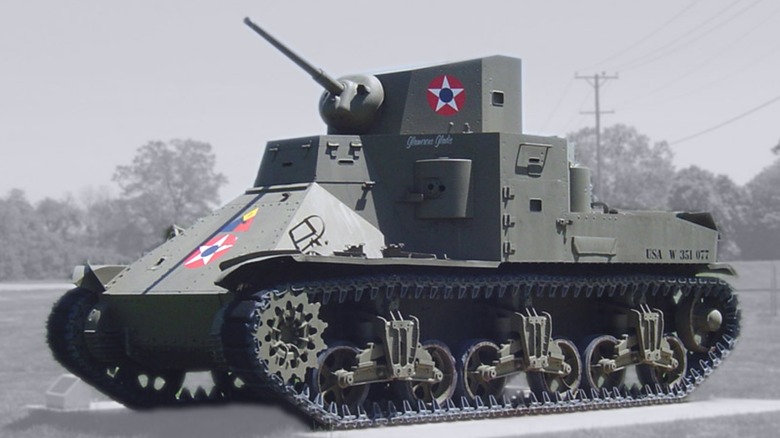Everything To Know About The American T5 Military Tank
The United States has employed a variety of tanks on different battlefields over the years, beginning with the nation's first tank, the M1917, during World War I. Tank development somewhat stalled after the conflict, and in the leadup to World War II, the U.S. decided it was time to turn away from previous designs and begin anew. This resulted in the development of a new medium tank initially designated as the T5.
The American T5 medium tank entered development in the 1930s and was built using the M2 light tank as a baseline model. The resulting design looked very different from previous models, though it housed the same transmission, engine, and suspension as its predecessor and the M1 Combat Car. What separated the T5 from earlier tanks was its armor and firepower, both of which were increased to compensate for growing threats to armored vehicles on the battlefield.
Improvements to the tank led to several innovations in tank design for the U.S., though development took several years. Testing commenced in late 1937, but the turrets weren't available at the time. As tests continued, the tank was upgraded from 15 tons to 20, and more changes modified its appearance, armament, and armor. Ultimately, the T5 ended its testing phase with the T5 Phase III, which entered development as the M2 medium tank used by the Americans early in WWII.
[Featured image by Fat yankey via Wikimedia Commons | Cropped and scaled| CC BY-SA 2.5]
What is the American T5 medium tank?
The T5 was the testing designation for the armored vehicle that would become the M2 and M2A1. The tank incorporated several lessons learned from past conflicts, observations of the then-ongoing Spanish Civil War, and the potential threat posed by German anti-tank weapons. The resulting M2s were produced in relatively small numbers and proved useful until the Army developed the M3 Lee and M4 Sherman medium tanks.
The T5/M2 was crewed by five personnel and weighed in at 19 tons. The tank's armament included a 37mm main gun mounted into a 360-degree rotating turret. Additionally, the tank hosted two .30 caliber machine guns on sponson mounts, four .30 caliber machine guns mounted to rotors in the sponsons, and two additional .30 caliber machine guns fixed in either bow. For armor, the tank boasted several thicknesses spread across the vehicle, ranging from one inch in most areas to three-eighths inches on the top.
The tank's 350 horsepower engine could push it up to 26 mph, and it had an operational range of around 125 miles. The Rock Island Arsenal initially produced 18 M2 tanks, leaving the U.S. Army with only a handful of modern medium tanks when it entered the conflict. The Army wanted 1,500 M2A1 models, but Rock Island Arsenal couldn't meet the demand. Ultimately, only around 94 M2A1s were produced before the Army canceled the contract to make room for the M3, which was in full development by August 1941.
[Featured image by Raymond Douglas Veydt via Wikimedia Commons | Cropped and scaled]
How did the tank perform and what happened to it?
The T5 and its subsequent production models, the M2 and M2A1, had a limited operational service record during WWII, and they never saw overseas combat. By the time the United States entered the war, the M3 was in full production, leaving the M2 in the dust, as it was considered obsolete. This left the Army with 112 modern medium tanks that didn't match up to the demands of the European battlefield, so the tanks were relegated to training tankers for the conflict.
This provided training in a modern vehicle, but it kept all of the tanks back in the rear. The remaining tanks were all retired in 1945 at the end of the conflict. When WWII ended, and the Army returned M3s and M4s to the States, the M2, and M2A1 were obsolete in comparison and were no longer suitable for training due to the surplus of available modern medium tanks.
Most of the tanks built during the war were scrapped, and only a few remain. You can check out a beautifully restored M2A1 at Aberdeen Proving Grounds, but finding a T5 is a bit more difficult. The U.S. Army Armor & Cavalry Collection has a prototype T5E1 on display (pictured), but for the most part, the tank and its variants have been lost to history.


